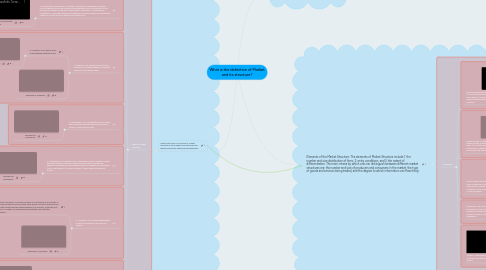
1. Elements of the Market Structure: The elements of Market Structure include 1. the number and size distribution of firms, 2. entry conditions, and 3. the extent of differentiation. The main criteria by which one can distinguish between different market structures are: the number and size of producers and consumers in the market, the type of goods and services being traded, and the degree to which information can flow freely.
1.1. Vocabulary
1.1.1. Product differentiation: In economics and marketing, product differentiation (or simply differentiation) is the process of distinguishing a product or service from others, to make it more attractive to a particular target market. This involves differentiating it from competitors' products as well as a firm's own products.
1.1.2. Market System: A market system is any systematic process enabling many market players to bid and ask: helping bidders and sellers interact and make deals. It is not just the price mechanism but the entire system of regulation, qualification, credentials, reputations and clearing that surrounds that mechanism and makes it operate in a social context.
1.1.3. Trade: involves the transfer of the ownership of goods or services from one person or entity to another in exchange for other goods or services or for money. Possible synonyms of "trade" include "commerce" and "financial transaction". A network that allows trade is called a market.
1.1.4. Consumers: The consumer is the one who pays to consume goods and services produced. As such, consumers play a vital role in the economic system of a nation. Without consumer demand, producers would lack one of the key motivations to produce: to sell to consumers. The consumer also forms part of the chain of distribution.
1.1.5. Goods: In economics and commerce, products belong to a broader category of goods.
2. Definition: the concept of a market is any structure that allows buyers and sellers to exchange any type of goods . Examples: Food market, real state market, etc.
3. Market Structure: In economics, market structure is the number of firms producing identical products which are homogeneous.
3.1. Types of Market Structure
3.1.1. 1. Monopolistic Competition: It is a type of imperfect competition such that many producers sell products that are differentiated from one another (e.g. by branding or quality) and hence are not perfect substitutes. In monopolistic competition, a firm takes the prices charged by its rivals as given and ignores the impact of its own prices on the prices of other firms.
3.1.1.1. Examples of Monopolistic Competition
3.1.2. 2. Oligopoly: The market is run by a small number of firms that together control the majority of the market share.
3.1.2.1. 2.1 Duopoly: It is a special case of an oligopoly with two firms.
3.1.2.1.1. Examples of Duopoly
3.1.2.2. Examples of Oligopoly
3.1.3. 3. Monopsony: It is a market structure in which only one buyer interacts with many would-be sellers of a particular product.
3.1.3.1. Examples of Monopsony
3.1.4. 4. Oligopsony: It is a market form in which the number of buyers is small while the number of sellers in theory could be large. This typically happens in a market for inputs where numerous suppliers are competing to sell their product to a small number of (often large and powerful) buyers.
3.1.4.1. Examples of Oligopsony
3.1.5. 5. Monopoly: It is a market where there is only one provider of a product or service.
3.1.5.1. 5.1 Natural Monopoly: A natural monopoly is a monopoly in an industry in which high infrastructural costs and other barriers to entry relative to the size of the market give the largest supplier in an industry, often the first supplier in a market, an overwhelming advantage over potential competitors.
3.1.5.1.1. Examples of Natural Monoploly
3.1.5.2. Examples of Monopoly
3.1.6. 6. Perfect Competition: Describes markets such that no participants are large enough to have the market power to set the price of a homogeneous product. Because the conditions for perfect competition are strict, there are few if any perfectly competitive markets. Still, buyers and sellers in some auction-type markets, say for commodities or some financial assets, may approximate the concept.
3.1.6.1. Examples of Perfect Competition

